How To Grow A Daphne Bush To Fill Your Garden With Fragrance
With its evergreen leaves and fragrant flowers that often bloom in late winter, the Daphne bush has a lot going for it. But it can be a little tricky to grow. Find out all our tips on how to plant and care for Daphne as well as our favorite varieties.
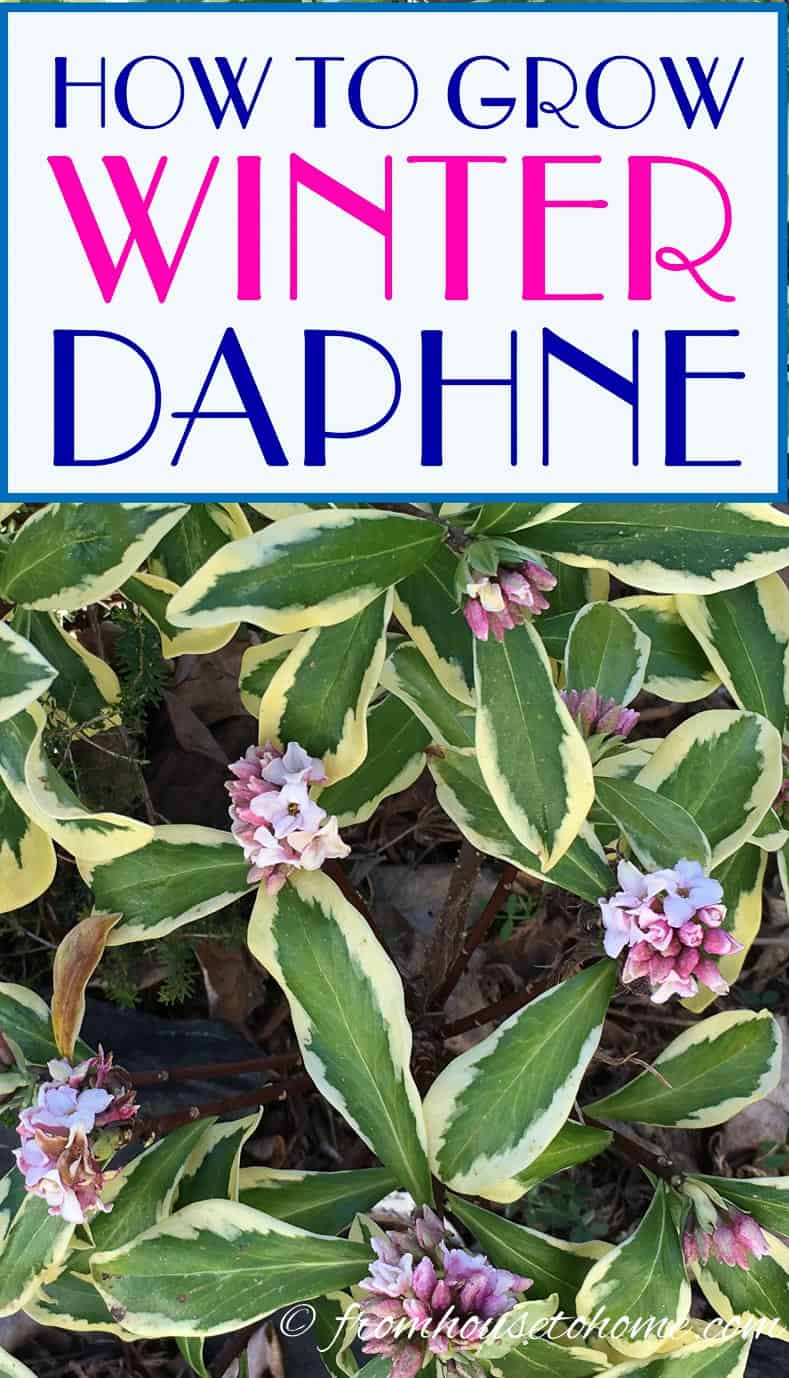
My first Daphne plant was an accident. Okay, not really an accident…just not planned for.
I went to an end of season plant sale a few years ago and came home with a small evergreen shrub that was supposed to bloom in the late winter.
Since finding plants that flower in the winter is hard to do, I thought I would give it a try.
I planted it on the side of my house and it seemed to do quite well. In February it had a couple of pretty blooms, and I was thrilled. It really does bloom in winter!
And then it died.
The next year, a friend of mine was at another plant sale, and found a variegated Daphne for a really good price. So she bought it for me.
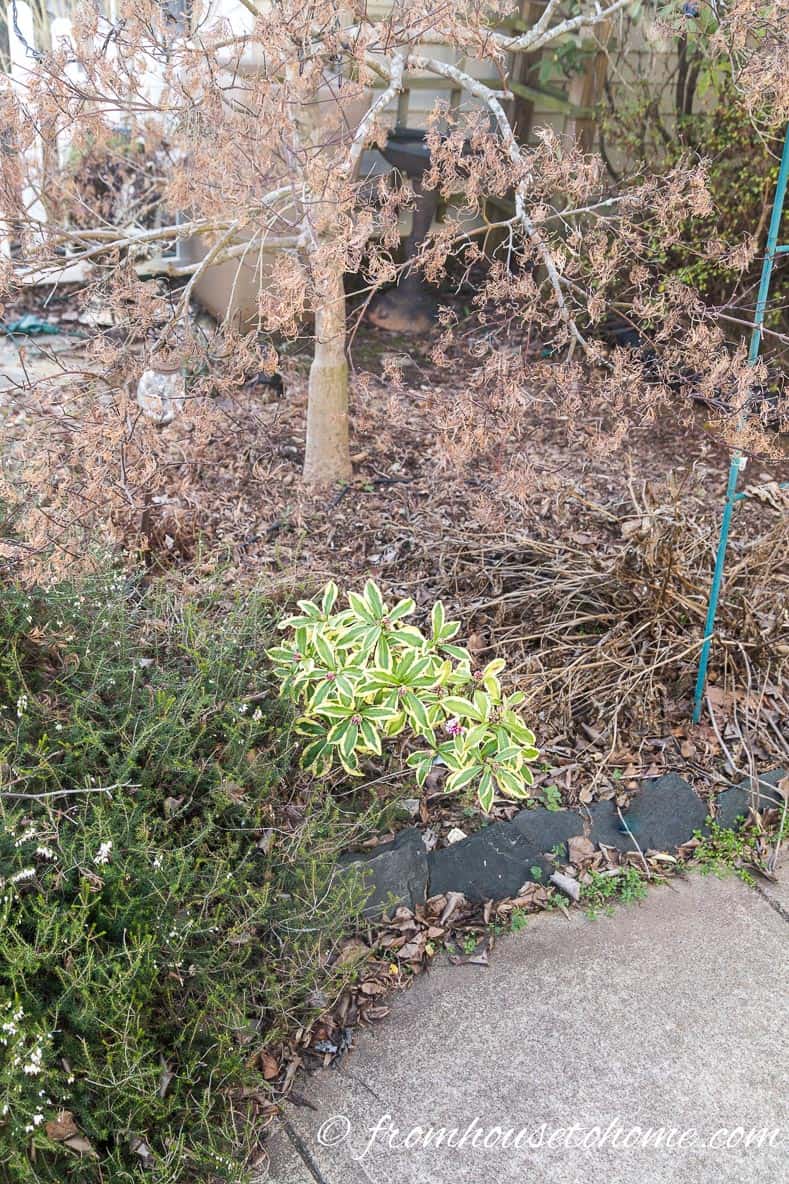
This time, I planted it in the front yard under my Japanese maple, right by the front walk.
This one survived for a couple of years. And then it died, too.
Then I planted another one by the walkway on the other side of the house. And this one survived!
It blooms every year and I know when it has started even if I can't see it. Because I can small the fragrance all the way from the front door.
So that's how I learned both how finicky Daphne is, and why I wanted it in my garden anyway.
Since then, I have accumulated a few more Daphne shrubs (and had a couple more die), but I think I have finally figured out how to grow them successfully.
Keep reading to find out what I've learned about growing Daphne bushes.
Characteristics

Zone: 5 – 10 (depending on variety)
Exposure: Partial shade
Height: 3′ to 5′
Width: 3′ to 5′
Bloom time: Most bloom in late winter, a few varieties in spring or summer
Flower color: Pink, white or purple
Daphne bushes are a family of fairly small, mostly evergreen shrubs that usually do best in part shade.
Their foliage varies from dark green leaves to variegated depending on the variety.
Most grow between 3 feet to 5 feet tall which size makes them an excellent choice for smaller gardens.
They produce small clusters of flowers that are extremely fragrant and usually appear in late winter or early spring. However, some varieties bloom later in the spring or early summer and do not have a scent, so check the tags when you're buying them.
As I mentioned above, they can be a little tough to get going. But once they are established, they are very low care.
Daphne shrubs are poisonous. If you have pets that like to chew on branches, you'll want to be careful about where you plant it.
However, that toxicity also make them deer resistant.
Where and how to plant Daphne Shrubs
Having grown a few of these garden plants now, one thing I know for sure is that they can be a little fickle.
So I have a few tips on how to plant them to give them a better chance of growing successfully.
Give them the right amount of light
Most prefer to be planted in part shade (such as the dappled sun under trees), although some will take more sun or more shade depending on the variety you get.
Give them some protection
Daphne bushes don't like to be exposed to strong winds or harsh sunlight.
So make sure to put them in a location that will protect them from those conditions.
Prepare the soil
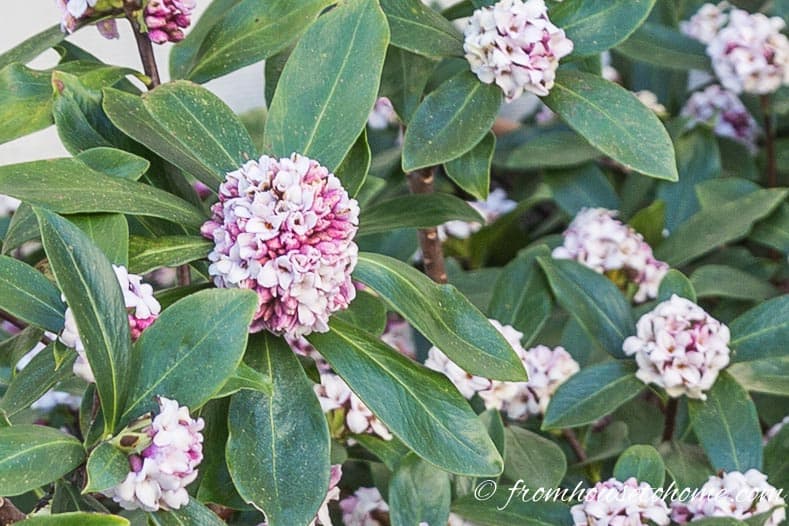
Well-drained soil that isn't too wet or too dry is a must! If the soil is too wet, root rot will set in and your plant will not survive.
Since I live in an area that has clay, drainage can be a problem. So I mound the soil up a bit to make sure the Daphne plants have a good base to grow in. And add lots of organic compost.
Depending on who you talk to, Daphnes grow in either alkaline soil or acidic soil. So I'm not sure what the truth is. But I can tell you that my soil is acidic and they seem to do just fine (I don't add anything to make the soil around them less acidic).
Plant Daphne in its forever home
To get Daphne to survive, it's important to plant them in the right location from the beginning.
Which is true of most plants, but even more so for Daphne because they are almost impossible to transplant.
The Daphne shrub has a large network of fine roots that really don't like to be disturbed, so trying to move them later almost never works.
Plant them quickly
Daphne doesn't do well in containers.
So you'll want to get it out of the pot it came in and into the ground as soon as possible.
And because its roots don't like to be disturbed, avoid buying bareroot plants.
How To Care For Daphne

Although Daphne is finicky getting started, once it gets established, it is actually really easy to maintain.
I think it's primary need is to be left alone which is perfect for the lazy gardener like me 🙂
Mulch
Mulch is a big help in keeping the soil moist, and Daphne really seems to appreciate it.
So making sure the bush has a 3″ to 4″ layer of mulch around it is an easy way to keep it happy.
Water
Water it, but only when the soil is getting dry.
It survives better being a little too dry rather than a little too wet.
Don't prune

Daphne rarely require pruning, and doing so seems to set them back (so I avoid it).
If you do need to prune it for some reason, keep in mind that many Daphnes bloom on old wood. In other words, they start forming buds for the next year's flowers the summer before.
So you'll want to prune them right after they finish blooming if you still want to have flowers in the spring.
No fertilizer
I don't fertilize my Daphne shrubs, either.
Because of their large root system, Daphne is particularly good at getting nutrients from the soil.
So most will do just fine without regular fertilizing as long as they have adequate water.
And chemical fertilizers can burn those fine roots causing more harm than good.
Daphne Varieties
These are some of my favorite varieties of Daphne.
Daphne odora

Zone: 7 to 9
Exposure: Part shade
Height: 4′ to 5′
Width: 4′ to 5′
Bloom time: Late winter
Flower color: Pink or white
Daphne odora (or Winter Daphne), as the name implies, has very fragrant blooms that start appearing in late winter.
Most have pink or white flowers and evergreen leaves.
I love the variegated varieties (such as the ‘Aureo Marginata' cultivar pictured above) because the leaves really stand out in the shade border, even when the plant isn't blooming.
Daphne x transatlantica ‘Eternal Fragrance'

Zone: 6 to 9
Exposure: Partial shade
Height: 2′ to 3′
Width: 2′ to 3′
Bloom time: Early spring and early fall
Flower color: Pink
Eternal Fragrance Daphne is an evergreen variety with dark green glossy leaves that blooms on both old and new wood.
That means, it blooms in spring on the old wood, and then blooms again in late summer through fall on the new wood. I figure why settle for a Daphne that only blooms once a year when you can have one that blooms twice?
It's also a low grower so it fits well in small gardens.
And it still has that beautiful fragrance that Daphne's are known for.
Daphne x transatlantica ‘Summer Ice'

Zone: 6 to 9
Exposure: Partial shade
Height: 3′ to 4′
Width: 4′ to 6′
Bloom time: Summer to fall
Flower color: Pink
As the name implies Summer Ice Daphne is one of the varieties that blooms later in the season.
So if you want to have that beautiful Daphne fragrance in your garden all summer long, this is the one to get.
It has pretty white flowers and grey-green semi-evergreen leaves that are edged with white.
Daphne x burkwoodii

Zone: 4 to 8
Exposure: Partial shade
Height: 3′ to 4′
Width: 3′ to 4′
Bloom time: Mid spring to early summer
Flower color: Pink
Daphne burkwoodii is a small rounded shrub that has pink flowers which fade to white, semi-evergreen foliage and a beautiful fragrance.
Many of the varieties (such as ‘Carol Mackie') also have variegated leaves which adds to their beauty all year round.
This variety is a little more tolerant of cold winter weather than most Daphne plants so is a great selection for Northern gardeners.
Daphne genkwa
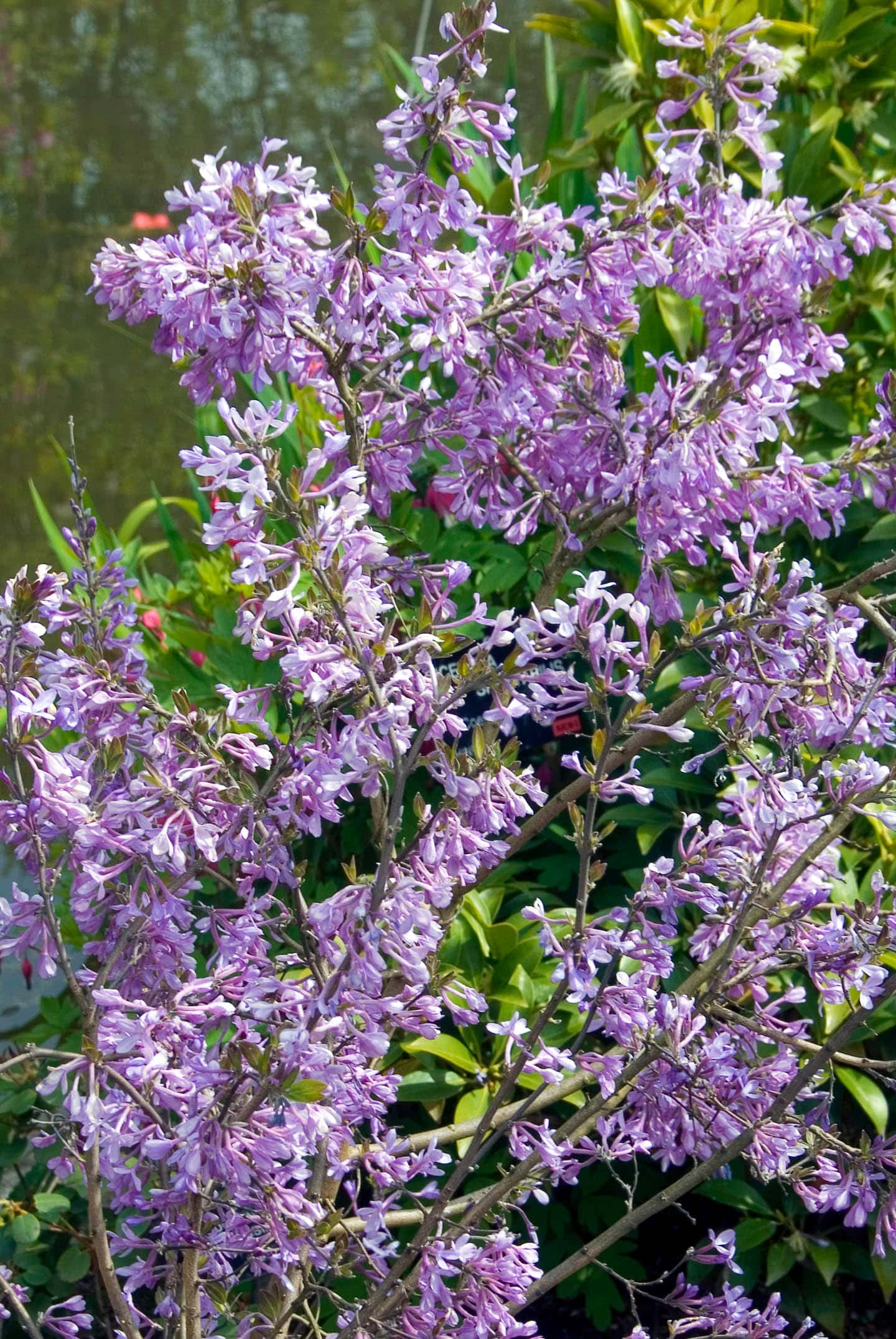
Zone: 4 to 7
Exposure: Sun to part shade
Height: 3′ to 4′
Width: 3′ to 4′
Bloom time: Late spring
Flower color: Purple
Daphne genkwa (or Lilac Daphne) is another type of Daphne shrub that has quite different characteristics than the ones I've mentioned so far.
It blooms in full sun in the late spring and unfortunately does not have the evergreen leaves or the wonderful fragrance as the others.
However, I still include it on my list of favorites because of its stunning purple flowers that are great for cutting. They make it worth your while even if they don't have a scent.
Hopefully you have found some inspiration to grow your own wonderfully scented Daphne shrub, even if they can be a little finicky 🙂
Other shade shrubs you might like
Have comments or questions on how to grow a Daphne bush? Tell us in the section below.
This post was originally published on September 5, 2017 but was updated with new content on November 23, 2024.

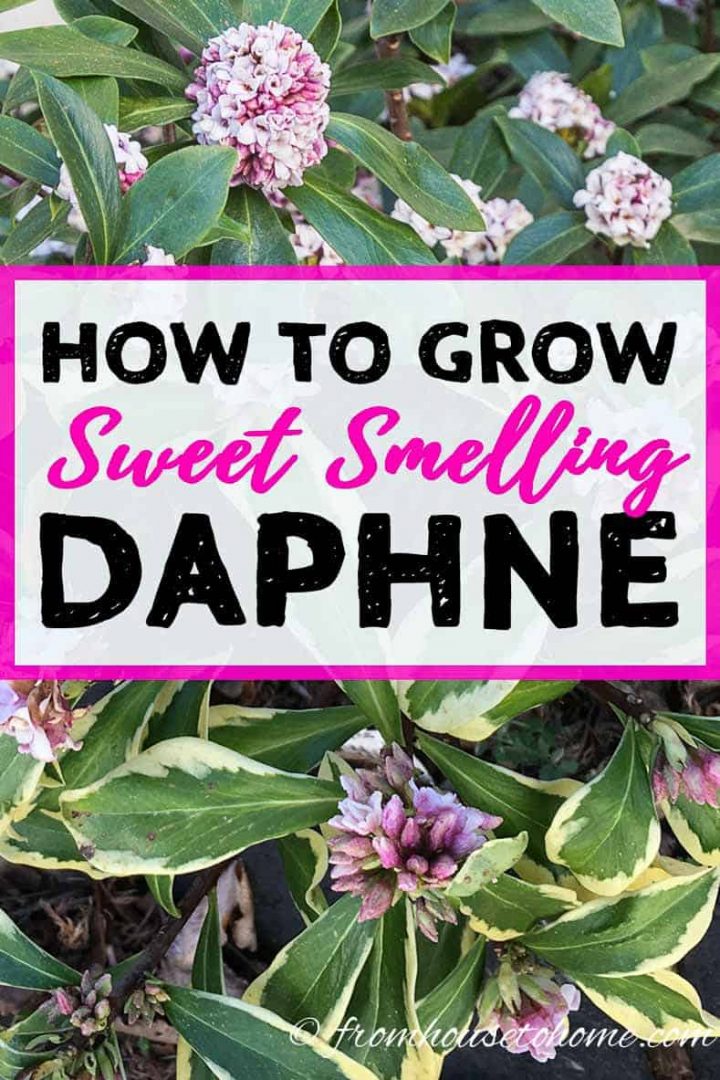







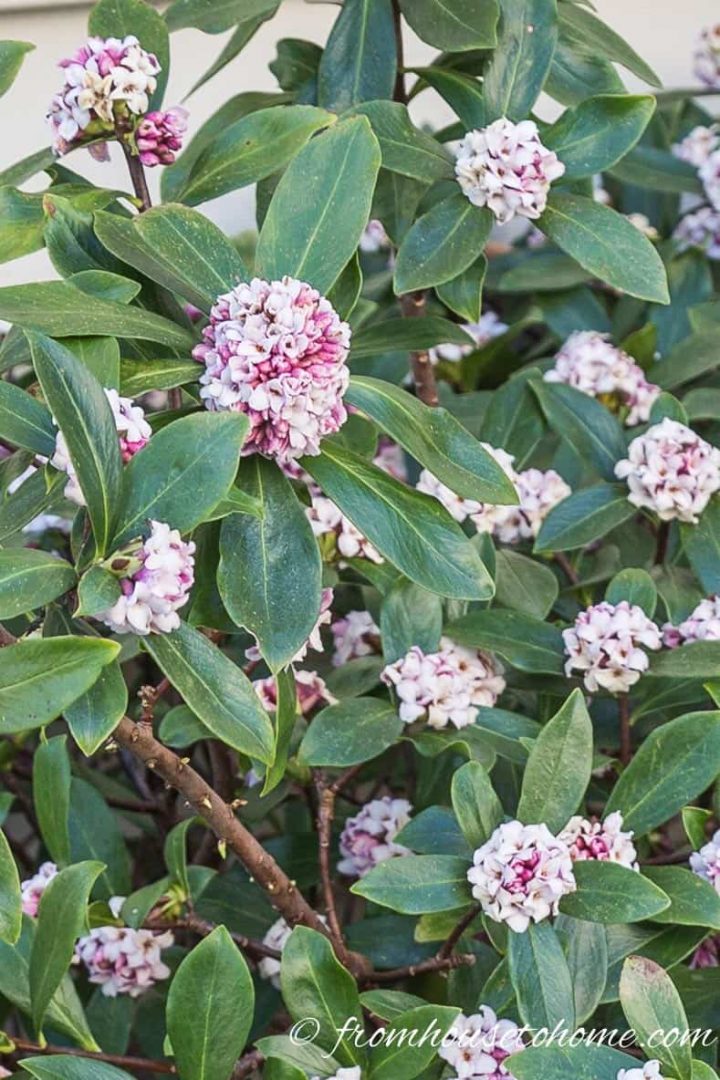

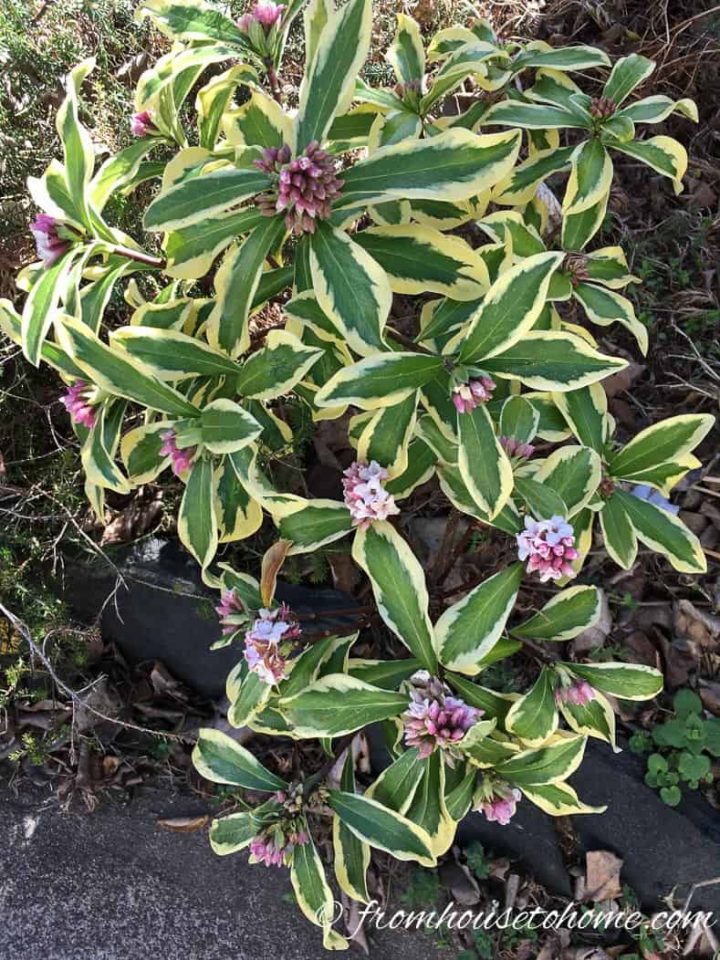












Hi I have a tiny Daphne plant, which started off well but now the leaves have suddenly started going yellow.
I give it minimal water and placed it in a shady position in its own small pot. Since the yellowing I have brought the plant inside to see if this helps with a bit of humidity.
Its Winter in Melbourne Australia.
I always wanted to grow Daphne again I had it as a shrub in a previous home and it thrived, without much attention.
Appreciate your advice. Thanks in advance. Andrae
Hi Andrae…it could be that the soil isn’t acidic enough. I would try adding a little Rhododendron fertilizer to see if that helps.
2 years ago I purchased a daphne. It lots its leafs, looked to be dying. I lifted it out of the pot, put rooting hormone on it, put into a plastic bag, and yea! I now have leaf but, sparingly. What else can I do to encourage the growth? It was placed in a smaller pot to encourage the root growth. Any suggestions?
Hi Sarah…I have never had very good luck growing Daphne in pots, so you’re doing better than me 🙂 I would try adding some Rhododendron fertilizer to see if that helps.
My Daphne (aromatic tiny white flowers) is overtaking my garden; how & when can I trim? I live in Portland,OR area.
Thanks for your assistance.
Hi Faye…It sounds like you have a Daphne that’s happy where it’s planted 🙂 Prune it soon after it has finished blooming if you don’t want to lose next year’s blooms. Try to pick a dry day to do it so there’s less chance of a fungal disease getting into the cuts. And I wouldn’t cut it back too much all at one time because they can react badly if they are severely pruned.
Thank you very the advice; I love that the Daphne is happy; it’s taking over the garden!!
Hi Wanda,
I am so glad I found your site! We recently moved from the cooler East Bay Hills of San Francisco further inland where summer heats get into the 100+ degrees. Our old house had a lovely and very fragrant 15 yr old Daphne that thrived on total neglect under a Japanese Maple canopied by a 70+ year old Oak Tree protected by a historical city ordinance. Now I have a Daphne in a large pot but the coolest part of the yard gets morning sun/afternoon shade but still 100+ in June – August. I do have soil space on this cool side of the house. Does that sound like a doable location? And…I have had it for 2+ months (bought it after the winder bloom on sale) and it seems wilted looking. PLEASE ADVISE! 🙂
Hi Kimberley…you might be able to make it work in your morning sun/afternoon shade location. Try to keep the soil cool and moist (but well drained). I suspect it would do better in the ground than in a pot. Adding a thick layer of mulch would probably help. Drooping leaves are usually a sign that it either has too much water or not enough (if it’s in a pot, make sure that the pot is draining properly). Good luck with it!
Hi, my three daphnes keep geeing mealy bugs. Are you able to let me me know how and why this happens and how to eradicate them. It’s been so hard keeping on top of them.
Thanks and lovely site x
Hi Kate…Mealy bugs are difficult to get rid of since they’re good at hiding in crevices and under leaves where you can’t see them. Spraying with horticultural oil works pretty well. If you have a lot of ants around, getting rid of them may help (ants protect mealy bugs from other predators because they eat the honeydew mealy bugs leave behind).
Hi Wanda,
Love your site! I have 7 good sized variegated Daphnes and 2 smaller babies, 1 1/2 tall. The larger ones are 7 to eight years old. They are all very healthy and beautiful.
I live in Roswell, Ga a sub of Atlanta. Sharing this with you and your readers because the nurseries in our area can’t believe they are living. They say “Daphnes just don’t grow well in our area”. I’ve found this not to be true! I took some photos but it doesn’t seem I can send them in the email. Thanks for reading!
Thanks, Diane! It’s great to hear your Daphnes are doing so well 🙂
how can you propagate daphne?
Hi Ann…I haven’t tried propagating Daphne myself so I don’t have any good tips for that. But I found this article that does a pretty good job of explaining it: https://homeguides.sfgate.com/grow-daphne-cuttings-26615.html
Hi,
I am in NSW, Australia, it is early Winter here, very pleasant weather.
I am an extremely keen Daphne Fan, but attempt to grow them in Pots.
I have added Scoria and Perlite, for drainage to an azaelia potting Mix.
I have Daphne Adora, and Daphne Adora Alba.
I have my Pots in a very Sheltered position, they receive good light, filtered sunlight, minimal wind.
I have wattered them after Transplant with Season, and have added Daphne Food To the Potting mix.
I have put extra holes into my two Light Coloured Ceramic pots for added drainage.
I do not know how else to keep my Daphne alive?
Any further Hints or Tips to assist me please?
Cheers,
Kerrie
Hi Kerrie…it sounds like you are doing all the right things for your Daphne plants. Make sure they are well-watered but not standing in water and hopefully they will do okay. They are a little tricky to get going so it may take a couple of tries. I have never tried growing them in pots, but I think they would need quite large ones since they like to have room for their roots to grow without being disturbed.